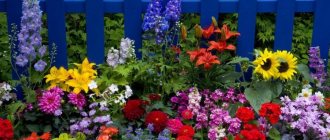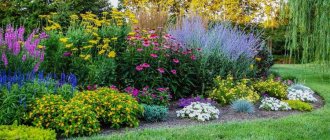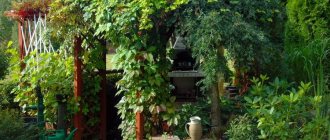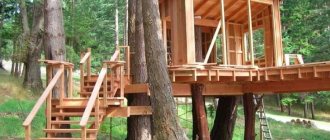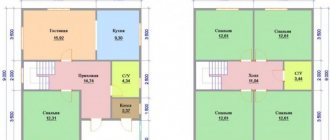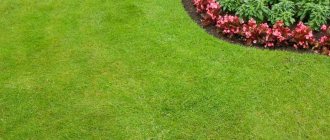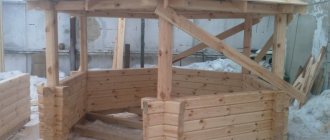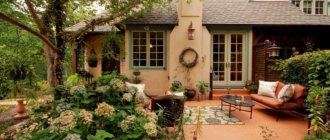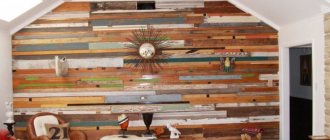Review author: Terra Design School
Many people try to arrange a flower bed in their garden with their own hands. This solution will allow you to beautifully and originally decorate your local area and enjoy the flowering of plants from early spring until frost. Let's look at all the secrets of designing flower beds in detail.
Selecting flower crops
To make flower beds at the dacha pleasing to the eye, it is recommended to select plants that replace each other. There are a variety of flower crops. Plants of different heights are usually selected for arranging the site.
The design of a flower bed will sparkle with new colors when choosing the following options:
- Astilbe looks attractive. It is represented by many varieties. Tall and short varieties look beautiful. Astilbe grows well in shaded areas; flowering can be admired within 7-10 weeks.
- You can't take your eyes off Helenium. The plant takes root well in the sun and shade. The crop is perennial and can withstand significant sub-zero temperatures without shelter. Helenium bushes will delight you with flowering with minimal care. They are planted in the center of the flowerbed or along the edges, depending on the design idea.
- Geranium has large inflorescences. The plant is unpretentious. Grows well. Flowers appear profusely from late spring to mid-summer.
- Catnip blooms luxuriantly. You can enjoy them in June-July. The plant is frost-resistant and does not need shelter.
- The oriental poppy looks attractive. Pleases with lush flowering with minimal care.
- The cuff is characterized by unpretentiousness. It grows to a height of 50-70 centimeters, producing lush flowers.
- Sedum multiplies quickly. Produces lush flowers with minimal care. Grows well in shaded areas.
- Rudbeckia is distinguished by its diversity. With proper care it can grow up to 2 meters in height. For this reason, it is better to plant rudbeckia in the central part of the flower beds.
There are many options for flower crops that will decorate the site in an original way. Already a photo of beautiful flower beds can attract attention. What can we say about seeing them live?
Beautiful combination of flowers in a flower bed
You can, of course, randomly plant plants in a flower garden, regardless of the color of their flowers. Such a motley picture will perhaps be more reminiscent of a natural landscape. But this is unlikely to be the best option, unless, of course, you are creating something like a rock garden.
It is more logical to plant plants in the flower garden that match well in color, as well as in the original shape of the leaves. This allows you to create successful compositions.
Here is an example of a successful combination of some plants in a flower garden:
- phlox and lilies;
- phlox and rudbeckia;
- echinacea and sedum;
- phlox splayed and subulate;
- phlox subulate and iris;
- peony and lupine;
- peony and catnip;
- bluebell and foxglove;
- dicentra and corydalis;
- hakonechloa and hoofweed;
- astrantia and filipendula.
As an example of creating a flower garden at your dacha with your own hands, I suggest you watch this video.
Creation of regular flower beds and flower beds
To make flower beds beautiful, they are decorated, giving the area various shapes:
- One type of plant is needed to create borders. Usually low-growing flower crops are used for arrangement. Begonia looks attractive in a flowerbed at the dacha in combination with marigolds, ageratum and others. You can also use these plants to border areas with other flower crops.
- When arranging parterres, flowers grow in the form of patterns. Typically, this involves the use of bright and lush types of flowers, various landscape sculptures or fountains.
- Various options for flower bed shapes look attractive. Square, oval, triangular, and round ones are especially often arranged. Planting flowers can be in strips located next to a fence, paths or around a gazebo.
- A complex ornament made from plant crops looks original. Arabesques are especially often arranged in this way.
Purchased designs
Modern technologies make it possible to produce phytomodules for vertical gardening on an industrial scale. They are assembled into a column, arch or phytowall. The variety of frame shapes allows landscape designers to create extraordinary flower beds.
A set of modules makes it easy to create a vertical flower bed in your garden with your own hands.
Rules for arranging flower beds
To arrange a flower bed, compliance with various rules is shown, which are as follows:
- selection of plants that replace each other, looking decorative and attractive;
- use of flower crops with the same requirements;
- planting varieties that are compatible in height so that they do not block each other;
- planting crops in groups depending on variety;
- using 10 types of flowers in one decorative flower bed.
Perennial flowerbed for beginners
Flower garden puzzle of the most popular flowers - assemble it yourself!
- Tall representatives of the flora for the center of the composition:
Roses, astilbe, lilies, asters, claricas, peonies, black cohosh, Hassler's cleome, delphinium, decorative onions, phlox, helenium, Zopnik ruselovsky, lupine multifolia, clematis, hosta, hydrangea, rudbeckia, liatris spicata, poppy, meadow bells, ratibida columnar , echinacea, daylily and many others.
- Medium-growing perennials for a modest addition:
Tulips, anemone, irises, fragrant rue, navel tincture, aquilegia, beautiful small petal, mountain cornflower, hybrid catnip, magnificent dicentra, oak sage, gravilat, yarrow ptarmika, heuchera, bergenia, lavender angustifolia, primrose, fern, evening primrose quadrangular, etc.
- Ground cover plants for edging flower beds and filling gaps:
Chistets Byzantina, acena, small periwinkle, creeping tenacious, Renard's geranium, aubrieta, Carpathian bellflower, grass carnation, lobularia, spring umbilical cord, Waldsteinia, lungwort, small periwinkle, speedwell and others.
It is recommended to plant tall soloists individually, but small flowers are best planted in groups, several at a time. At the same time, in a flowerbed viewed from different angles, taller individuals should be planted closer to the center, and shorter ones should be planted along the edges.
Advice. To prevent bald spots from gaping in the flowerbed and weeds from growing, plant the plants as close to each other as possible, but not too crowded.
Want to achieve continuous flowering? Find out about the characteristics of each flower, write down the flowering time on a piece of paper and create your own combination diagram of a beautiful club of perennials, in which some plants will bloom in early spring, others in mid-summer, and others will bloom until late autumn.
Of course, thinking through the ideal design for a luxurious flower garden is a special task. But, fortunately, there are proven designs for flower beds of perennials.
How to plant flowers
The flowerbed will look attractive in the following case:
- The center is planting perennial plants, including bulbous plants. A place with a diameter of 20-50 centimeters is shown for them, which will give them the opportunity to subsequently grow.
- At the next stage, annual crops are planted. It is also necessary to leave space between seedlings. This will give them the opportunity to grow.
If unsightly bald spots appear on the site, you should fill them by planting crops. Usually the procedure is carried out 2-3 weeks after the main work in the spring, when it becomes clear what the territory will be like.
What to plant - onions or perennial flowers?
Not everything in the garden should be for the belly, you need to leave room for “beauty” - just for the soul. A flowerbed of continuous flowering perennials can easily decorate even the most inconspicuous area, giving it a unique charm. Roses, geraniums, carnations, poppies and asters will grow in the same place season after season without requiring special attention.
A question that every novice gardener must understand is the choice of plants for a perennial flower garden. From practical experience, the first flowerbed should be made small and planted with unpretentious flowers that grow well under the bright sun.
A flowerbed is a bright element of the garden, so there is no point in planting it in the far corner of the site or hiding it under the shade of trees. The optimal solution for creating a perennial flower bed would be a place that is clearly visible from all sides.
Multi-level flower beds (with tall plants in the background and short ones in the foreground) are usually placed near the walls of a house, a fence or hedge. Whereas in the center of the site, a constantly blooming flowerbed of perennials can either form all sorts of combinations of plants, or be decorated with only one species.
Flowerbeds of perennials in the garden and country house
Secrets of care
To improve the appearance of a landscaped flower bed, you should regularly care for the flower crops growing here.
It is recommended to water flower crops regularly. This will extend their flowering period. To carry out the procedure, it is recommended to use water that has stood for several days. Otherwise, the seedlings may get sick and die. In hot weather, it is recommended to water the plants every day. The procedure is carried out after sunset. Otherwise, the sun will burn the tender leaves of the crops.
Regular fertilizing is recommended. This will give the plants strength to grow and bloom. The soil is fertilized for the first time during the planting process. Then you should feed the plants until flowering time. Next, fertilizers are applied regularly, alternating mineral with organic.
In order for flower crops to grow better, it is recommended to regularly loosen the soil. Care must be taken when carrying out the procedure. Otherwise, you can damage the delicate root system.
Regularly remove weeds from the area. Otherwise, it will displace cultivated plants from the territory, taking away their beneficial substances.
It is necessary to treat plants with special means to prevent the development of dangerous diseases. The procedure is performed with special preparations, diluting them in accordance with the recommendations prescribed on the packaging.
With minimal care for the cultivated plants growing here, the flower beds will delight the eye for a long time. Flowers in this case will delight you with good growth and lush flowering.
Examples of the best flower beds for a summer residence
As they say, it is better to see once than to read five times. Therefore, let's look at the most successfully implemented flower beds. Maybe you will like some ideas and you can implement them at your dacha.
Photos of flower beds
Recommended planting patterns
Beginner gardeners are better off practicing in a small area with good lighting. It is important not only to choose the right varieties, but also to correctly distribute the plants in the flower garden. In this case, it is necessary to take into account the size of the buds, inflorescences, the shape of the petals and leaves, the height of the stems and bushiness. In order for the composition to look as natural as possible, it is necessary to strictly follow the layout when planting according to the chosen scheme.
Simple planting scheme
To create the composition, unpretentious, hardy perennials are used. The flowerbed can be round, square, triangular. The following plants are used:
- The first planted in the center is paniculate phlox, purple and pink. You can do this in the fall or spring. Blooms all summer and September.
- Pink astilbe is planted in front of it. It begins to bloom a little earlier than phlox and ends in August;
- The daylily is placed on the same line with the astilbe. Planting is carried out in spring in well-drained soil.
- Heuchera is used for edging. Its silvery leaves will highlight a flower garden at any time of the year. Blooms in May, earlier than all collected species;
- You can make accents with the help of magnificent geranium bushes. Light flowers appear in mid-summer and remain until the end of the season.
Flowerbed of plants blooming in the first year
- The tallest hollyhock roses are planted in the background. You can use one variety or plant single plants of several colors. They will bloom in mid-summer;
- At the same level, the place is prepared for sunflowers. It grows quickly, so you should provide more space for it. Blooms in August until cold weather;
- Spanish poppy will be an excellent addition to a long-flowering flower bed. The first buds appear in May;
- St. John's wort is placed on the midline. It will catch the blooms of early species in June;
- For lobelia cardinalis, make room in the center. Thanks to the original leaves and bright flowering, it always remains attractive;
- The first lavender catnip flowers appear in May;
- The lower level is planted with bells. Already in June they will create a dense blue carpet;
- The beautiful blue baskets of Catananche “Blue Cupid” can be admired all summer long;
- The blue color of the lower part of the flowerbed dilutes the perennial gravel;
- The largest inflorescences of the sedum “Matrona” linger in the flowerbed the longest;
- Unusual leaves and flowers of Heuchera "Miracle" - a spectacular decor for a flower garden in the middle of summer.
Flowerbed in shades of pink and red
- Variable knotweed is placed in the center. White flowers appear on a large shrub in midsummer;
- Monarda hybrid attracts not only its stunning pink color, but also exudes a refined aroma;
- The purple leaves and red small flowers of astrantia look great as an edging;
- The opposite side of the flower bed is decorated with Saxifraga pachyfolia. The first inflorescences appear in May;
- The bright composition is successfully complemented by the “Dragon” phlox. A place is allocated for him in the center;
- Heuchera, with deep red leaves, bursts with color in June;
- The lush geranium “Compactum” adds bright red tones to the flower garden;
- The riot of colors is diluted by the soft pink flowers of the sedum “Matrona”;
- Loddon Anna bells fill the garden with a subtle aroma.
Main advantages
The popularity of vertical gardening is explained by the versatility of the designs. They take up little space, which allows them to be used in small yards and terraces. They are easy to care for.
Vertical frames can be easily disassembled for storage and reassembled when spring arrives. Such flower beds need to be fed and watered more often to provide the plants with all the necessary substances.
The structures are not difficult to build, so summer residents often use them to decorate their plots.
Advantages and disadvantages
Before you create a vertical flower bed on your site, you need to become more familiar with its advantages and disadvantages. Among the positive aspects of arranging vertical flower beds it is worth noting:
- the possibility of effective zoning of a personal plot;
- minimal costs for obtaining consumables;
- ease of installation work;
- ease of maintenance;
- quick dismantling for winter storage;
- possibility of manufacturing a mobile structure;
- versatility of use;
- compactness;
- high decorative qualities.
Despite the whole list of advantages, vertical flower beds and flower beds also have their disadvantages, including:
- rapid depletion of soil substrate;
- need for frequent irrigation/feeding procedures;
- not suitable for growing perennial crops;
- additional shelter for the winter is required.
Vertical design of flower beds and flower beds allows you to save free space near the house, in the recreation area. Tip! To ensure that vertical flower beds made by yourself do not lack moisture, you can add polymer compounds - hydrogel - to the soil, or use mulch, or properly organize a drip irrigation system.
What flowers to use in vertical gardening
Strongly growing, unpretentious annuals are most suitable for growing in a vertical plane: nasturtium, lobelia, begonia, brachycoma, alyssum, eschscholzia, mirabilis. The first place in this list is occupied by petunia: its thin stems are quite flexible and long, thanks to which they beautifully hang down, forming a lush cap strewn with flowers.
Selection of types of flowers
Creating a beautiful flower bed is a creative process that can completely absorb any gardener. This is a great way to realize your potential as a creator. By choosing the right plants for your flower beds, you can create a real living work of art on your site.
Making a flower garden from annuals
Scheme of a triangular flower bed
A huge number of seeds of all kinds of flowering plants are now sold on store shelves. Which ones are best suited for creating flower beds? First of all, focus on the growth and flowering period of plants, as well as the color of their petals.
Table. The most popular types of flower plants for flower beds .
| Name | Flowering period | Height, cm |
| Lobelia | June-September | About 15 |
| Ageratum | July-October | 15-70 |
| Iberis | June-October | Up to 40 |
| Marigold | June-September | 15-100 |
| Nasturtium | June-October | Creeping up to 400, bush 50 |
| Petunia | June-mid October | 15-80 |
| Zinnia | June-October | 20-70 |
Also, low-growing annuals include: dwarf begonia, viola, lobularia, dwarf aster; for tall ones: lupine, peony, astilbe.
raised flower bed
Prices for annual seeds
annual seeds
Mixborder scheme with photo
mixborders - flower beds, the stylistic features of which are inherent in the name - are more appropriate, and even more popular “Mix” - different plants are used in the design: perennials and annuals, of different heights, dissimilar in appearance, blooming at different times of the season. “Border” - characterizes the location of the flower bed: along alleys, buildings, around lawns, etc. As a rule, mixborders are much simpler to arrange and look “more lively” in comparison with an elegant border.
When planning plantings of different heights, you can use the correct rule, according to which the tallest plants are located in the middle (or at the far edge, if the flower garden is located, say, near a wall), the lowest ones are at the edge, as are the round, bushy ones.
Read also “Tornado” - a weed killer. Description, methods of use, dosage
Strawberry
Beds for tasty and sweet berries can be located on a vertical structure. This option allows you to solve the problem of lack of space to obtain a good harvest. Strawberry beds are made from vertical or hanging pipes.
Thanks to this system, plant roots will not be damaged by rodents. The site owner can easily control soil moisture.
Tips for creating vertical strawberry beds
The innovative method of growing strawberries has appealed to many gardeners, even those who have enough space on their plot to grow berries using the traditional method. But creating vertical beds has its own nuances. For example, if the structure is quite large and heavy, it is recommended to assemble it in a permanent place. This will eliminate the need to move a bulky structure from one point to another. Also, when choosing a location, you need to take into account that strawberries love sunny areas.
In winter, plants should be protected from prolonged subzero temperatures, since, being in a confined space, the root system can freeze very much. If the flower bed is collapsible and consists of flower pots, boxes and other containers that are easy to move, they are stored in a cool room in winter.
If the bed is made of a pipe, it is laid on the soil and then covered with geotextiles and spruce branches. In addition, a layer of snow is piled on top. You should do the same with a flowerbed made from a barrel, although you don’t need to turn it over, just protect it with covering material.
How to make a vertical bed from PVC pipe - watch our video:
dizlandshafta
Photos in garden design
Photos of original vertical flower beds made with your own hands are presented below.
Vermiculite, perlite or sphagnum moss placed on the bottom of the pot are suitable as drainage. A metal stand with a flowerpot will not leave anyone indifferent, the flowerbed looks dignified and luxurious. Non-standard solutions when decorating the local area are a win-win option in order to achieve effectiveness. It is convenient and beautiful to plant vertical flower beds with climbing ones. plants, with their help you can increase the decorative characteristics Vertical gardening can decorate any wall and attract the attention of others
A video on how to make a vertical flower bed with your own hands is presented below:
